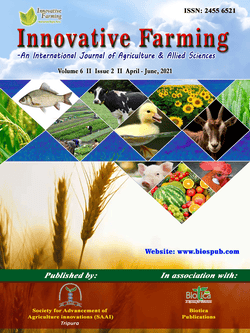
Insect Pest Resistant Breeding in Plants
Tridip Bhattacharjee*
College of Agriculture, Tripura, Lembucherra, Tripura (799 210), India
Thingreingam Irenaeus
College of Agriculture, Tripura, Lembucherra, Tripura (799 210), India
Budha Ch. Thangjam
College of Agriculture, Tripura, Lembucherra, Tripura (799 210), India
Tapan Kumar Maity
College of Agriculture, Tripura, Lembucherra, Tripura (799 210), India
Arup Chattopadhyay
Dept. of Vegetable Science, Faculty of Horticulture, Bidhan Chandra Krishi Viswavidyalaya, Mohanpur, Nadia, West Bengal (741 252), India
DOI: NIL
Keywords: Breeding strategies, Insect, Mechanism, Resistant breeding
Abstract
Development of insect resistant cultivars has been a part of the plant breeder’s tool since long time. This is especially at this juncture, when there is growing public sensitivity about the environment and residual effects on produce due to the indiscriminate use of hazardous chemicals and emergence of new races/ biotypes. The source of resistance may be present in the indigenous cultivars, land races, folk, semi-wild relatives and allied species of vegetable crops. The development of varieties with resistance to biotic (insect) stresses involves manipulation of two genetic systems i.e., plants and other of the pest, not independently, but with regard to the interaction between the two systems. Resistance may be generated by mono or oligo or polygenes and effects of genes may be additive or dominant or epistatic. Methodologies of breeding for resistance may be grouped into two: conventional and non-conventional. Conventional include selection, introduction, hybridization and mutation breeding. While non-conventional include somaclonal variation, genetic engineering and molecular breeding. In spite of considerable similarities in the evolution of pathogens and insects especially in relation to plants, relatively less efforts have been directed to develop pest resistant than disease resistant varieties. Breeding for host plant resistance is switching from conventional viz., introduction, selection, hybridization towards non-conventional approaches like genetic engineering and molecular approaches, as later has broadened the scope of gene manipulations at the level of specific DNA segments across wide range of organisms to produce novel genomes with enhanced levels of resistance to biotic (insect) stresses or resistance.
Downloads
not found
Reference
Acquaah, G., 2020. Principles of Plant Genetics and Breeding, 3rd Edition. Wiley-Blackwell Publishing, Inc. p. 848.
Amin, M.R., Chakma, A., Alam, M.Z., Hossain, M.M., Ge, F., 2016. Screening of tomato varieties against tomato fruit borer and associated plant characters SAARC Journal of Agriculture 14(2), 150-161. DOI: https://doi.org/10.3329/sja.v14i2.31255.
Chahal, G.S., Gosal, S.S., 2010. Principles and Procedures of Plant Breeding: Biotechnological and Conventional Approaches. Narosa Publishing House Inc. pp. 360-398.
Chattopadhyay, A., Sharangi, A.B., Dai, N., Dutta, S., 2011. Diversity of genetic resources and genetic association analysis of green and dry chillies of Eastern India. Chilean Journal of Agricultural Research 71(3), 350-356. DOI: http://dx.doi.org/10.4067/S0718-58392011000300002.
Frageria, M.S., Arya, P.S., Choudhury, A.K., 2001. Vegetable Crops Breeding and Seed Production, 1st Edition. Volume I. Kalyani Publishers, Ludhiana. p. 247.
Gogi, M.D., Ashfaq, M., Arif, M.J., Khan, M.A., 2009. Screening of bitter gourd (Momordica charantia) germplasm for sources of resistance against melon fruit fly (Bactrocera cucurbitae) in Pakistan. International Journal of Agriculture and Biology 11, 746-750.
Jouanin, L., Bottino, M.B., Girard, C., Morrot, G., Giband, M., 1998. Transgenic plants for insect resistance. Plant Science 131, 1-11.
Kashyap, R.K., Kalloo., 1983. An appraisal of insect resistance in vegetable crops - A review. Haryana Journal of Horticultural Science 12, 101-118.
Kumar, P.A., 1999. Genetic engineering for insect resistance in vegetable crops. In: Summer School on Advanced Technologies in Improvement of Vegetable Crops Including Cole Crops. (Ed.) Singh, N. IARI, New Delhi.
Lin, J., Dickson, M.H., Eckenrode, C.J., 1984. Resistance of Brassica lines to the diamondback moth (Lepidoptera ponomeutidae) in the field, and inheritance of resistance. Journal of Economic Entomology 77(5), 1293-1296. DOI: https://doi.org/10.1093/jee/77.5.1293.
Mishra, R., Rout, E., Joshi, R.K., 2019. Identification of resistant sources against anthracnose disease caused by Colletotrichum truncatum and Colletotrichum gloeosporioides in Capsicum annuum L. Proceedings of the National Academy of Sciences, India - Section B: Biological Sciences 89, 517-524. DOI: https://doi.org/10.1007/s40011-018-0965-1.
Painter, R.H., 1958. Resistance of plants to insects. Annual Review of Entomology 3, 267-290. DOI: https://doi.org/10.1146/annurev.en.03.010158.001411.
Pompon, J., Li, X.Q., Pelletier, Y., 2011. Resistance level to an aphid potato pest varies between genotypes from the same Solanum accession. Journal of Economic Entomology 104(3), 1075-1079. DOI: https://doi.org/10.1603/EC10278.
Prabu, T., Warade, S.D., Saidi, M., Baheti, H.S., 2009. Screening wild and cultivated okra species for resistance to important pests. Indian Journal of Plant Protection 37(1and2), 87-91.
Rakha, M., Zekeya, N., Sevgan, S., Musembi, M., Ramasamy, S., Hanson, P., 2017. Screening recently identified whitefly/spider mite-resistant wild tomato accessions for resistance to Tuta absoluta. Plant Breeding 136(4), 562-568. DOI: https://doi.org/10.1111/pbr.12503.
Samota, R.G., Jat, B.L., Choudhary, M.D., 2018. Varietal screening of chilli, Capsicum annum L. against major sucking insect pests. Journal of Entomology and Zoology Studies 6(1), 995-999.
Sharma, H.C., Sharma, K.K., Seetharama, N., Ortiz, R., 2000. Prospects for using transgenic resistance to insects in crop improvement. Electronic Journal of Biotechnology 3(2), 76-95. DOI: https://doi.org/10.2225/vol3-issue2-fulltext-3.
Singh, B., Rai, M., Kalloo, G., Satpathy, S., Pandey, K.K., 2007. Wild texa of okra (Abelmoschus species): Reservoir of genes for resistance to biotic stresses. Acta Horticulturae 752, 323-328. DOI: https://doi.org/10.17660/ActaHortic.2007.752.55.
Srinivasan, R., 2008. Integrated pest management for eggplant fruit and shoot borer (Leucinodes orbonalis) in South and Southeast Asia: Past, Present and Future. Journal of Biopesticides 1(2), 105-112.
Tewari, G.S., Deshpande, A.A., Ananad, N., 1985. Chilli pepper genotypes resistant to thrips, Scirtothrips dorsalis Hood. Capsicum Newsletter 5, 73-76.
Verbitskii, N.M., Pokazeeva, A.P., 2015. In: Breeding Pea for Immunity to Bruchus pisorum. (ed. Sekeltsiya I semenovod zern I kormov kul’tur). Rostov-on-Don, USSR.
Yousafi, Q., Afzal, M., Aslam, M., 2016. Screening of brinjal (Solanum melongena L.) varieties for resistance to brinjal shoot and fruit borer (Leucinodes orbonalis G.). Pakistan Journal of Zoology 48(6), 1649-1663.
